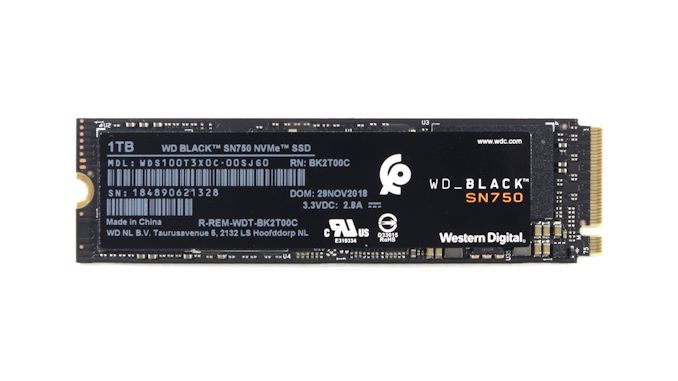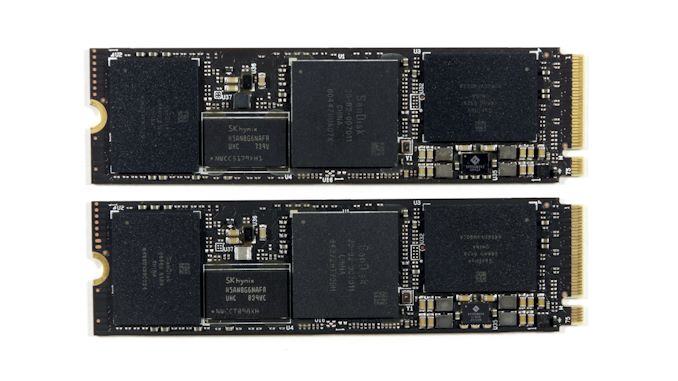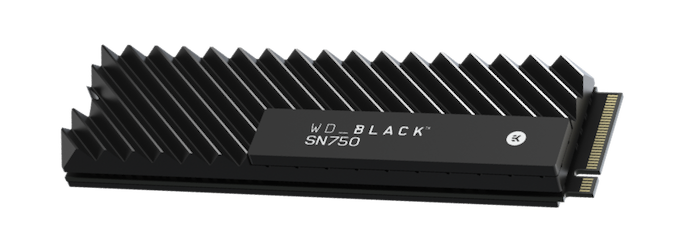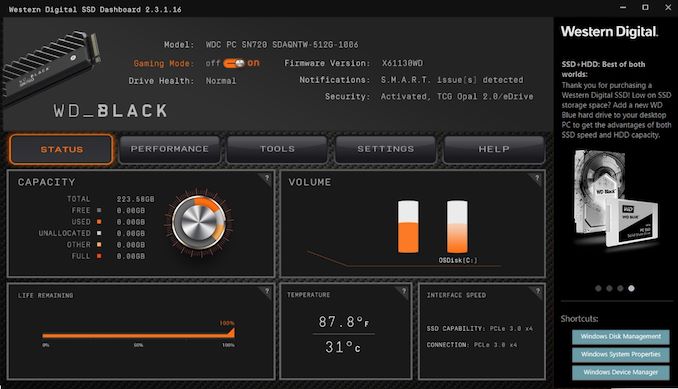The Western Digital WD Black SN750 SSD Review: Why Fix What Isn't Broken?
by Billy Tallis on January 18, 2019 8:01 AM EST
Last year Western Digital overhauled their WD Black NVMe SSD with an upgrade to 3D NAND and a new in-house SSD controller, transforming the product line from one of the slowest NVMe drives to one of the top high-end competitors. Now the third generation WD Black SSD is here, with the model number SN750 to avoid confusion with its predecessors. (Internally, last year's model was known as the SN700, and the OEM version was the SN720.) The new WD Black SN750 is an incremental update over last year's model, keeping the same basic controller and 64L 3D NAND combination but refining the firmware and adding a 2TB option. Western Digital is also shifting their marketing efforts more toward gamers with the addition of SKUs featuring a large heatsink.
The second-generation WD Black launched last year delivered performance that is generally competitive with other top NVMe SSDs like the Samsung 970 EVO, while usually operating with far better power efficiency. The only other high-end NVMe SSDs that have similar efficiency are the Toshiba XG5 and XG6, but the controller they use puts them clearly in a lower performance class than the WD Black. However, last year's model was still the first release of a new controller architecture, so it is no surprise that Western Digital has some firmware improvements to deliver. It is a bit disappointing that those improvements aren't being distributed as free firmware updates to owners of last year's model, but Western Digital is not the only company that's taken this approach.
| Western Digital WD Black SN750 Specifications | ||||||
| Capacity | 250 GB | 500 GB | 1 TB | 2 TB | ||
| Form Factor | M.2 2280 single-sided optional heatsink (except 250GB) |
|||||
| Interface | PCIe 3 x4 NVMe 1.3 | |||||
| Controller | Western Digital in-house | |||||
| NAND Flash | SanDisk 64-layer 3D TLC | |||||
| Sequential Read | 3100 MB/s | 3470 MB/s | 3470 MB/s | 3400 MB/s | ||
| Sequential Write | 1600 MB/s | 2600 MB/s | 3000 MB/s | 2900 MB/s | ||
| Random Read | 220k IOPS | 420k IOPS | 515k IOPS | 480k IOPS | ||
| Random Write | 180k IOPS | 380k IOPS | 560k IOPS | 550k IOPS | ||
| Power | Peak | 9.24 W | 9.24 W | 9.24 W | 9.24 W | |
| PS3 Idle | 70 mW | 70 mW | 100 mW | 100 mW | ||
| PS4 Idle | 2.5 mW | 2.5 mW | 2.5 mW | 2.5 mW | ||
| Warranty | 5 years | |||||
| Write Endurance | 200 TB 0.4 DWPD |
300 TB 0.3 DWPD |
600 TB 0.3 DWPD |
1200 TB 0.3 DWPD |
||
| MSRP (No heatsink) |
$79.99 | $129.99 | $249.99 | $499.99 | ||
Aside from the addition of the 2TB option, the most noticeable changes to the specs table are the vastly lower MSRPs: the 2TB will debut for only $50 more than the 1TB model was at introduction last year, and the smallest price drop is the 33% cut to the 250GB model's price tag.
Performance has been improved slightly across most of the major metrics, but none of the improvements are anything huge. The 2TB model will actually be slightly slower than the 1TB, due in part to using 512Gb NAND dies instead of 256Gb dies so that the 2TB model can still be a single-sided M.2 card.
The 2TB model and the SKUs equipped with heatsinks will be arriving this spring, but the plain 250GB through 1TB models ship this month. Western Digital has not provided MSRPs for the models with heatsinks, but we expect them to carry a bit of a premium when they arrive.
Peeking under the label, we find essentially the same PCB as last year's model, though it appears we've gone from revision A to revision D. The WD Black SN750 is equipped with the same controller and NAND parts as last year's WD Black and SanDisk Extreme Pro, and the only differences in chip markings appear to be date codes or lot numbers.

Top: 2nd Gen WD Black (SN700)
Bottom: 3rd Gen WD Black SN750
Unlike last year's model, the new WD Black SN750 does not have a sibling product under the SanDisk brand; the SanDisk Extreme Pro NVMe SSD is now strictly speaking an outdated product, though it is still very similar to the new WD Black.
Western Digital has made a few superficial changes to the WD Black to make it more gamer-oriented. The product packaging and labeling has been restyled, and all but the smallest model will soon be available in versions with a custom aluminum heatsink from EKWB. Additionally, there's a new version of Western Digital's new SSD Dashboard software for Windows that adds a "Gaming Mode" which re-configures the NVMe driver to not enable Autonomous Power State Transitions. When this gaming mode is enabled, the drive won't make use of its low-power idle states, which avoids the extra latency of waking the drive up after it has been idle for a few seconds. However, in our experience few gaming desktops are configured to use the deepest idle states, and the WD Black wakes up very quickly from its intermediate idle, so this feature will be inconsequential for most users.
Our Linux-based synthetic performance tests are already conducted with APST off so that idle wake-up latency doesn't distort those results. Our Windows-based ATSB trace tests leave APST enabled, but the trace playback cuts idle times short enough that most NVMe drives won't be entering low-power states during those tests, either. The SYSmark 2018 test gives SSDs plenty of idle time to make use of their deepest idle states, but overall the workload it presents is not storage-intensive enough for WD's Gaming Mode to have a noticeable effect.
It may seem odd that Western Digital is sticking with their 64-layer 3D NAND even months after their partner Toshiba started shipping 96L 3D NAND with the XG6, but the transition to 96L NAND will look very different from the transition to 64L NAND. The 64L generation leveled the playing field as Toshiba and Western Digital delivered their first 3D NAND worth mass producing, and Intel and Micron made significant performance improvements over their previous 32L NAND. As most of the major manufacturers largely caught up to Samsung and ramped up production, prices crashed. That's been great news for consumers, but has prompted the manufacturers to slow their investments into 96L production to avoid worsening the oversupply. Thus, we expect the 96L transition to proceed more slowly, taking all of 2019 and probably into 2020 before every 64L product line gets upgraded. The 96L upgrade has the potential to bring some significant performance and power improvements, but will in most cases require a new generation of controllers that can take advantage of higher controller-to-NAND interface speeds or lower operating voltages.
Since last year's WD Black launched, the most important new competitors to hit the scene have been drives based on Intel/Micron NAND with the SM2262 controller, and drives using the same Toshiba/SanDisk NAND with the Phison E12 controller. The SM2262 drives (represented in this review by the HP EX920) are now being phased out in favor of the upgraded SM2262EN controller, which we previewed last year. Representing the Phison E12 family, we have the Corsair Force MP510 960GB.
| AnandTech 2018 Consumer SSD Testbed | |
| CPU | Intel Xeon E3 1240 v5 |
| Motherboard | ASRock Fatal1ty E3V5 Performance Gaming/OC |
| Chipset | Intel C232 |
| Memory | 4x 8GB G.SKILL Ripjaws DDR4-2400 CL15 |
| Graphics | AMD Radeon HD 5450, 1920x1200@60Hz |
| Software | Windows 10 x64, version 1709 |
| Linux kernel version 4.14, fio version 3.6 | |
| Spectre/Meltdown microcode and OS patches current as of May 2018 | |
- Thanks to Intel for the Xeon E3 1240 v5 CPU
- Thanks to ASRock for the E3V5 Performance Gaming/OC
- Thanks to G.SKILL for the Ripjaws DDR4-2400 RAM
- Thanks to Corsair for the RM750 power supply, Carbide 200R case, and Hydro H60 CPU cooler
- Thanks to Quarch for the XLC Programmable Power Module and accessories
- Thanks to StarTech for providing a RK2236BKF 22U rack cabinet.
















54 Comments
View All Comments
Oxford Guy - Monday, January 21, 2019 - link
It's weird to review minor products and not review something major like the GTX 960.It may be explainable without conspiracy but it's still weird, in terms of priorities.
Alistair - Friday, January 18, 2019 - link
Can't wait to read the SX8200 Pro review. I've bought a few, and I believe they are the best performing drives for the money right now. Excellent. I stopped buying Samsung after they started denying warranties in Canada (and they don't seem to want to fix that). Anyways the Samsung drives cost almost twice the SX8200 pro and perform exactly the same pretty much. Maybe the SX8200 Pro is even faster than the 970 EVO honestly.gglaw - Friday, January 18, 2019 - link
A few from decent reviewers are already up for this and the HP EX950 which are small upgrades over the incredibly well-rounded drives they replaced. The SX8200 (non-pro) and EX920 go on so many massive sales it is hard to beat them until the newer drives start dropping in price. The average home user would never know whether they had a 970 Pro, SX8200, SX8200 Pro, or EX950 running so major price differences would make the decision for me. After my initial experiences with the SX8200/EX920, these have been all I've stocked for close to a year. Made me almost regret my 970 Pro. They regularly go on sale for ~$75 for 500GB, and $135 for 1TB versions so my SSD adventures have become rather boring with no close 2nd place I would even consider buying.I'm likely going to get a SX8200 Pro just because I can't help myself with new versions of my favorite drives, but I'm already 99% positive I'll be in the same boat of not being able to tell any difference with the small upgrade. Then I'll have buyer's remorse again like the 970 Pro, knowing the 1TB version of the cheaper drive is barely more than the new 500GB one (SX8200 1TB $135, Pro 500GB $115).
ajp_anton - Friday, January 18, 2019 - link
What's wrong with WD's idle power consumption, and am I right assuming that that makes it unsuitable for laptops (mobile ones, not gaming)?Billy Tallis - Friday, January 18, 2019 - link
We test SSDs on a desktop, and that means we need to jump through some hoops to get PCIe power management enabled. I've never encountered a desktop motherboard that even has PCIe ASPM enabled by default, and when you are lucky enough to get a BIOS option to turn it on, you can't trust that to take care of everything. Even with the OS set to override the motherboard's settings, not all drives are able to enter their deepest sleep state on our testbed.I view this situation as being similar to DEVSLEEP for SATA drives. It's pretty likely that a laptop which was designed to use M.2 PCIe storage will have all the right firmware bits enabled to use the deepest power saving modes, but they're normally not used (or usable) on a desktop and I don't currently have equipment that can work around that.
hnlog - Saturday, January 19, 2019 - link
WD Black NVMe has problem on Linux with default parameter.Is it fixed on the new model?
https://community.wd.com/t/linux-support-for-wd-bl...
I think WD should test before shipping the former model.
Billy Tallis - Monday, January 21, 2019 - link
Basically every NVMe SSD vendor has shipped something that turned out to have serious power management bugs, most often with APST and only on certain host systems. It's pretty clear that no vendors (SSD or motherboard) are thoroughly testing those features before shipping, and instead just make sure that it works with a small handful of Windows configurations. But even the Windows NVMe driver is a moving target and new builds have caused problems.It would probably help if the UNH-IOL NVMe Integrator's List testing included APST, but their current test plan only checks whether the drive can handle manually setting power states. And even if they were more thorough, only a few vendors put consumer drives through that certification.
FXi - Sunday, January 20, 2019 - link
I wonder when we'll see the upper end of sizes in consumer drives jump to 4TB. Durability seems to be ready. Perhaps consumer need isn't quite there. But if controllers can handle it and layers exist for it to be built to that size in the M2 format, you'd think that's where they would go next since prices have come out of the stratosphere.eastcoast_pete - Sunday, January 20, 2019 - link
Is it just me, or do these comparisons make the HP 920 look quite good? Not in terms of top performance, but in performance/price. Has anybody here had any experiences with 920 drives?piasabird - Sunday, January 20, 2019 - link
Why not compare similar products together? Why is one drive a 2 TB drive? Since 2TB has more save locations it may naturally be faster due to drive space, cache size, energy usage, etc. Maybe Anandtech doesnt use samsung drives because Samsung will not donate the drives for free but other companies would give them free gear to test.